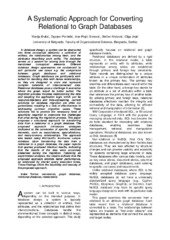Please use this identifier to cite or link to this item:
https://rfos.fon.bg.ac.rs/handle/123456789/2819Full metadata record
| DC Field | Value | Language |
|---|---|---|
| dc.creator | Đukić, Marija | - |
| dc.creator | Pantelić, Ognjen | - |
| dc.creator | Pajić Simović, Ana | - |
| dc.creator | Krstović, Stefan | - |
| dc.creator | Jejić, Olga | - |
| dc.date.accessioned | 2024-11-25T07:30:40Z | - |
| dc.date.available | 2024-11-25T07:30:40Z | - |
| dc.date.issued | 2024-01 | - |
| dc.identifier.issn | 1820-4503 | - |
| dc.identifier.uri | https://rfos.fon.bg.ac.rs/handle/123456789/2819 | - |
| dc.description.abstract | In database design, a system can be abstracted into three conceptual elements: a collection of entities, the relationships among them, and the attributes describing each entity. The database serves as a system for storing data through the mentioned conceptual elements. Different database design approaches are customized to suit particular use cases e.g. the comparison between graph databases and relational databases. Graph databases are particularly well suited for handling data with dense relationships, as they are designed to store and represent complex networks of interconnected data. Relational databases pose a challenge in scenarios where the graph would be better suited. The migration process involves restructuring the data and adapting the application logic which can be resource-intensive and time-consuming. Current solutions for database migration are often too generalized, resulting in a lack of effectiveness in addressing common migration cases. These solutions fail to provide the necessary level of specificity required to overcome the challenges that arise during the migration process. This paper proposes a structured approach for transferring data from a relational to a graph database. The proposed approach introduces strategies dedicated to the conversion of specific relational elements, such as associations, specializations, and many-to-many relationships. The approach was tested using Microsoft’s Northwind sample database. Upon transferring the data from a relational to a graph database, the paper reports that queries produced identical results, indicating that the details of the data were accurately preserved during the migration. Following an experimental analysis, the results indicate that the proposed approach exhibits better performance, as evidenced by shorter query execution times. These findings affirm the feasibility and veracity of the proposed approach. | sr |
| dc.language.iso | en | sr |
| dc.publisher | IPSI Transactions on Internet Research | sr |
| dc.rights | openAccess | sr |
| dc.subject | conversion | sr |
| dc.subject | graph database | sr |
| dc.subject | relational database | sr |
| dc.subject | relationship | sr |
| dc.title | A Systematic Approach for Converting Relational to Graph Databases | sr |
| dc.type | article | sr |
| dc.rights.license | ARR | sr |
| dc.citation.issue | 1 | - |
| dc.citation.volume | 20 | - |
| dc.identifier.doi | 10.58245/ipsi.tir.2401.03 | - |
| dc.identifier.fulltext | http://prototype2.rcub.bg.ac.rs/bitstream/id/4117/bitstream_4117.pdf | |
| dc.type.version | publishedVersion | sr |
| item.cerifentitytype | Publications | - |
| item.fulltext | With Fulltext | - |
| item.grantfulltext | open | - |
| item.openairetype | article | - |
| item.languageiso639-1 | en | - |
| item.openairecristype | http://purl.org/coar/resource_type/c_18cf | - |
| Appears in Collections: | Radovi istraživača / Researchers’ publications | |
Files in This Item:
| File | Description | Size | Format | |
|---|---|---|---|---|
| bitstream_4117.pdf | 559.52 kB | Adobe PDF |  View/Open |
Items in DSpace are protected by copyright, with all rights reserved, unless otherwise indicated.
